Fruit peeling is carried out using fruit acids. The goal is skin rejuvenation and reduction of oiliness. It is distinguished by its ability to influence the deep subcutaneous layers up to the dermis.

How is fruit peeling performed?
For cleaning, acids are used that are extracted using synthetic methods. The most common of them included in the products for the procedure:
- Glycolic acid, which is obtained from special plants. However, it can also be produced by chemical synthesis. This type of acid is characterized by a particularly pronounced exfoliating effect;
- Apple;
- Wine;
- Lemon;
- Dairy.
Fruit peeling for the face deservedly takes the place of the safest types of deep facial cleansing, since the procedure is characterized by superficiality, that is, it does not in any way affect the patient’s usual life activities.
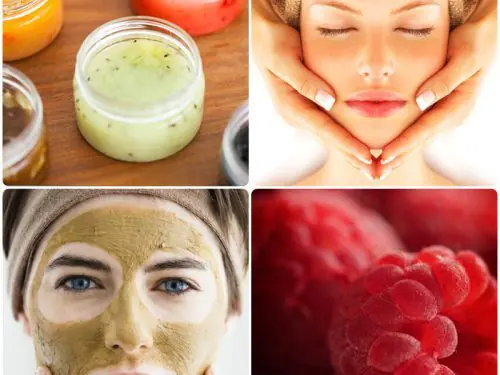
The types of fruit peeling are as follows:
- Glycolic;
- Grape;
- Wine;
- Citric;
- Dairy, etc.
How did he appear
Peeling, designed to cleanse the skin, appeared in ancient times on the territory of modern Rome. Back then, women performed similar procedures with grape and lemon juices. You can often hear an interesting thing from historians: Cleopatra herself often washed her face with sour wine and did not disdain milk baths.
Our ancestors actively used a variety of milk and fruit masks. Modern cosmetology actively uses a variety of acids that were discovered about two decades ago.
The popularity of peeling with fruit acids came from the United States of America, where this procedure was carried out primarily for cosmetic purposes. A little later, some time later, scientists found that carrying out such procedures can be useful not only as a medical measure, but also as a cosmetic one.
Working moments for fruit peeling:
- One or two weeks before the procedure, the patient's face is pre-prepared for it. Dead skin cells are removed from the skin, which can prevent the penetration of necessary substances and compounds into the deep layers of the dermis, as well as interfere with their interaction with these layers;
- Before starting the procedure, all makeup is removed from the face and preliminary cleaning is carried out;
- Next, the patient is placed on a couch, where the facial skin is once again cleansed with cosmetics;
- After this, the cosmetologist applies a special composition with a high content of fruit acids to the face. In this case, the patient may feel some burning or tingling, the reaction is considered normal;
- After a certain period of time, the composition is thoroughly washed off;
- At the end of the procedure, soothing and moisturizing compounds are applied to the skin.
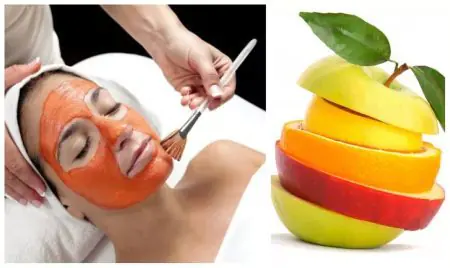
This is how facial peeling is carried out in the salon by specialist cosmetologists.
About frequency
How often peeling is required and the total number of procedures depends on the goals set by the cosmetologist or specialist, which are previously discussed with the patient to clarify the required program of procedures, just like Hollywood facial peeling.
So, if you need to cope with the signs of aging, then the concentration of acids in the composition will be from 20 to 50%. In this case, the average exposure time will be 1 minute. In total, no more than ten procedures are carried out in a complex with an interval of up to 7 days.
If you need to overcome excess oily facial skin, then the exposure time of the composition increases to 2 minutes, the number of procedures to 15, and the interval between them will be 2-3 days.
Fruit peeling is also used as a routine care measure. Then the composition will act for up to 7 minutes, there will be about two dozen procedures, and they will need to be carried out at intervals of a week.
Although the cosmetic measure is not recognized as capable of causing injury to the skin, it is recommended to take into account important features affecting peeling with fruit acids. This:
- Complete abstinence from cosmetics for a period of several days. In extreme cases, when there is a need to apply cosmetics, it is recommended to use strictly hypoallergenic varieties;
- For 2-3 weeks after the procedure, you will need to avoid active exposure to UV, visit solariums and sunbathe. This is why peeling with fruit acids is best done in the fall;
- The use of scrubs and exfoliating compounds should be avoided for 20-30 days.
The applied compositions are agreed upon with the patient in advance. Most often, fruit peeling is carried out over a period of one and a half months with equal intervals between procedures. The greater the concentration of the composition, the more effective it will be, however, along with an increase in the concentration of acids, the possibility of side effects and complications also increases. Milk peeling will be more gentle.
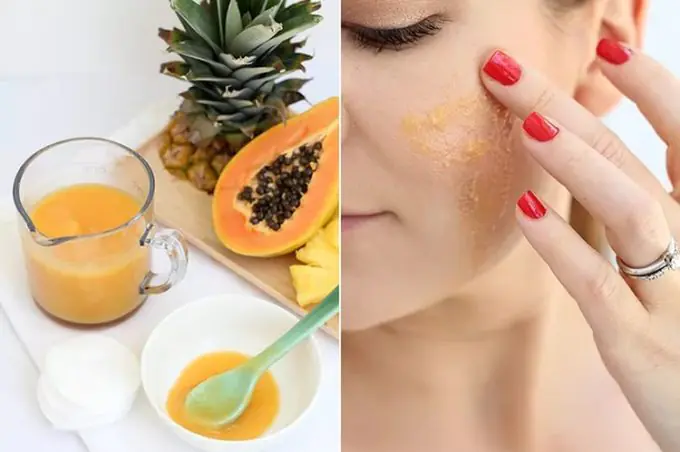
Indications for use
Indications for peeling are:
- Increased pore expansion;
- Acne scars;
- Problematic or oily skin;
- UV-damaged skin;
- Age spots;
- Decreased skin firmness and elasticity;
- Wrinkles and age-related changes in facial skin.
The results of peeling with fruit acids will be getting rid of the primary signs of skin aging. In this way, it can be restored to elasticity, overcome traces of scarring and restore order to the functioning of the sebaceous glands. Also, fruit peeling can significantly cleanse pores and overcome especially obvious pigment formations.
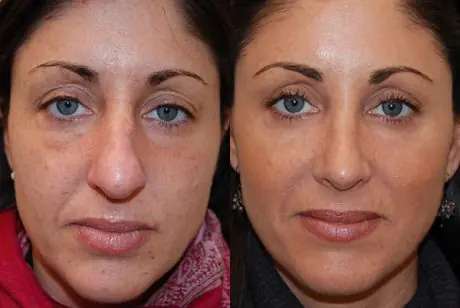
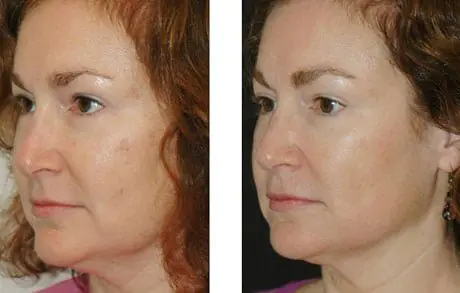
We spend it at home on our own
Fruit peeling at home for the face is possible and easy. Although it is best carried out in cosmetology centers, a home method is also possible. It is important to adhere to a certain algorithm of actions:
- Before the actual procedure, you will need to cleanse your face with foams or tonics, but if they are not at hand, ordinary warm water will do;
- After cleansing your face, you will need to apply a peeling composition. It is better to do this with light movements with elements of massage, without touching the areas around the eyes. For such purposes, applicators or brushes can be used;
- After expiration, the scrub is washed off with warm water;
- The composition that is planned for fruit peeling must be prepared in advance, but not earlier than half an hour, because there is a possibility that it will lose its properties over a long period of time. For homemade formulations, pineapples, papaya, lemon or apples are suitable;
- In order to prevent the occurrence of allergic reactions, it is advisable to test the prepared composition on the wrist or other part of the body (small). If the skin does not turn red and you do not feel a burning sensation or irritation, the composition can be used without fear;
- The essence of the peeling procedure with fruit acids is a gradual increase in concentration. So, if the very first “mask” had a concentration value of 5%, then the next one should have a concentration value of 10%.
One of the most popular services is facial peeling in the salon - this is an effective procedure that accelerates the natural renewal of the skin. Despite the fact that this method of cleansing practically does not injure the skin, it is in no way inferior in effectiveness to classical mechanical facial cleansing.
Peeling cleansing allows you to cope with serious facial defects: wrinkles, age spots, scars and cicatrices, rashes of any origin. The list of indications for using this method is very extensive. It is used:
- For acne;
- For hyperpigmentation;
- For peeling;
- When the skin is contaminated;
- With age-related changes.
The right type of peel can be found for any skin type. This technique can be used for both normal or oily and dry faces. Sensitive epidermis is also not considered an obstacle to this procedure.
The method allows you to exfoliate dead cells, restore the protective properties of the dermis, deeply moisturize the face, eliminate scars, stretch marks and wrinkles. It also has lifting and anti-inflammatory effects.
By constantly applying this cleansing, you can achieve smooth and well-groomed skin and eliminate any facial imperfections.
What is peeling?
What is salon facial peeling? This is a popular, highly effective technique aimed at launching skin renewal mechanisms. During this cleaning method, the upper layers of the epidermis are artificially removed, as a result of which the body's natural protective processes are stimulated. The synthesis of hyaluronic acid, collagen and elastin increases, the skin begins to renew and regenerate.
Peeling allows you to achieve the following effects:
- Increased tone and elasticity;
- Relief smoothing;
- Softening of the skin;
- Improved skin color;
- Getting rid of hyperpigmentation;
- Cleansing pores of sebaceous plugs and dirt;
- Anti-inflammatory effect;
- Smoothing wrinkles, scars, scars.
The effects of the peeling procedure depend on the depth of exposure, as well as on the product used. Let's take a closer look at what types of peeling exist and how they affect the skin.
What types are divided into according to the depth of action?
Peeling in the salon is divided into 3 main types: superficial, medium and deep. As the names suggest, this division depends on the depth of penetration a particular method is designed for.
Let's take a closer look at what each subgroup includes.
An easy and gentle method, suitable for people without obvious skin problems. Superficial salon peelings affect the granular and stratum corneum of the skin. The procedure is carried out quickly, within 20-30 minutes, the course includes no more than 10 procedures.
After superficial cleansing, light redness, blackheads, and skin impurities are eliminated. It reduces acne, reduces skin oiliness, improves complexion, deeply moisturizes and nourishes, and eliminates early wrinkles.
For serious defects, this method will not demonstrate the desired effect. Having late age-related changes, severe scars and spots, it is worth trying a different technique.
Medium facial peeling is prescribed for clients with serious age-related changes. All anti-aging cleansing methods used in beauty salons are based on this technique. It affects the deep layers of the epidermis, so it can be traumatic.
Medium peeling in beauty salons is carried out for expression and age wrinkles, strong scars, scars, potholes, stretch marks or folds. It is also a preparatory stage for plastic surgery.
Recovery from a midline peel can take up to 3 months.
The technique of deep facial cleansing is an aggressive, traumatic procedure. This method of cleaning is equivalent to operations. It is performed in a hospital setting, under anesthesia - both local and general. The choice of anesthesia depends on the area being treated and the client’s pain threshold.
The method allows achieving good efficiency. It eliminates deep wrinkles, double chins and jowls, and restores elasticity to tissues. It is recommended for women over 40 years of age who have severe oval sagging.
Restoration of the epidermis after deep cleansing lasts for six months or more.
What types are divided into according to the use of funds?
Types of facial peelings in salons are also divided by the type of products used. For facial peels, chemicals, laser or ultrasound, fruit acids, and mechanical devices can be used.
Let's look at each method in detail.
Chemical peeling for the face in the salon is carried out using acids, as well as other groups of drugs to exfoliate cells. It is divided into 3 large groups:
- Surface type, involving the application of solutions of various acids. The most commonly used is highly effective lactic acid. The procedure gets rid of the stratum corneum and increases the production of elastin and collagen.
- The middle type is based on the effects of trichloroacetic acid in varying concentrations. This subtype allows you to cope with wrinkles, age spots, potholes, and scars.
- Deep type, which is treated with phenolic mixtures. The procedure is performed in a hospital setting, without anesthesia. After the session, a crust forms on the face, which falls off over time, revealing healthy, clean, rejuvenated skin.
The duration of the procedure depends on the depth of the peeling effect, and varies from 15 to 60 minutes. Recovery after a session can take up to six months: during this time it is necessary to use sunscreen, as well as gentle cosmetics.
In contrast to mechanical cleaning, mechanical peeling is a technique based on the use of special equipment. Like the chemical method, it is divided into three groups: superficial, middle and deep.
- Surface cleaning is carried out using brushes. This is a rotating device with soft and natural bristles. The rotation speed can be adjusted, and special scrubs are used to improve the effect. It is used for mild deficiencies.
- Aluminum crystals are used for medial cleansing. They deeply exfoliate dead cells and accelerate the renewal of the epidermis. Depending on the pain threshold, the method can be performed under anesthesia or without it.
- The deep procedure is carried out using hard brushes rotating at high speed. Since the procedure is painful, anesthesia is used to perform it. This method is indicated for scars, scars, acne spots, and deep wrinkles.
The mechanical procedure can last from 20 minutes to 2 hours.
The physical facial peeling procedure is also divided into subgroups:
- Ultrasonic, which involves micromassage using an ultrasonic device. Ultrasound waves penetrate into the deep layers of the epidermis, improve blood supply, stimulate metabolism, and trigger cellular renewal.
- Laser, using carbon dioxide or erbium laser. This subtype is performed in a hospital setting, using anesthesia. It eliminates serious age-related changes and deep scars.
Diamond dust grinding is an effective way to exfoliate and cleanse the skin. To carry out this procedure, a special apparatus is used. Diamond grinding allows you to remove age spots, redness, and unevenness of the epidermis. It also copes well with inflammatory processes in the pores.
Fruit facial peeling is one of the subtypes of dry cleansing that has gained great popularity. It is a delicate cleansing method with virtually no contraindications. Cleansing is carried out using special compositions with acids:
- Lemon;
- Apple;
- Wine;
- Grape;
- Glycolic acid.
The fruit procedure cleanses the pores of sebum, dirt, and dead skin cells. It also fights bacteria, preventing inflammation on the face. The recovery period after the method lasts no more than 3-5 days.
How to choose a peel for your skin
When deciding which cleaning method to choose, focus on the following parameters:
- Your skin type: oily, dry, normal;
- Problems that need to be resolved;
- Contraindications to the procedure;
- The cost of a specific method;
- What does this type of facial peeling provide?
- How will facial peeling be carried out by a cosmetologist?
It is best to choose a specific method together with a cosmetologist. A professional will help you figure out which type of cleansing is best for your skin, and which types you should avoid for your indications. The specialist will also introduce you to the drugs on which the procedure will be carried out and provide information on prices.
How to peel in a beauty salon
Detailed instructions on how to do the procedure depend on the specific technique. Mechanical, physical or chemical peeling in the salon is very different from each other. However, all types of procedures have the same unchanging steps:
- Cleansing. The cosmetologist removes impurities, cosmetics, and sebum from the epidermis. For cleaning, professional products are used to dissolve dirt and grease.
- Opening of pores. The specialist warms or cools the patient's skin to expand the pores, thereby enhancing the effectiveness of the procedure. During this stage, warming masks, hot steam or cryotherapy are used.
- Peeling. The skin is cleansed using the chosen method: cosmetics, fruit acids or special equipment.
- Applying a mask. After cleansing the skin, a special mask is applied to it, selected according to the skin type and aimed at combating specific problems.
- Narrowing of pores. At the end of the session, the skin is covered with a special powder or cream that tightens the pores. This product protects the skin from pollution and bacteria and accelerates regeneration.
The description of the third stage depends on what type of cleaning is used in a particular case. Consult with a cosmetologist to choose the procedure that is right for you: in cosmetology, there is no such thing as “the best peeling.” When choosing a method, focus on the needs of your skin and how it feels.
Are there any contraindications?
Despite the fact that peeling is a safe and non-traumatic method of cleansing, it also has its contraindications. You should refrain from using this method in the following situations:
- Tendency to allergic reactions;
- The presence of herpes and warts on the face;
- Acute stage of acne;
- Taking certain medications;
- Inflammatory diseases;
- Benign and malignant tumors.
Also, many women prefer to refrain from procedures during pregnancy and breastfeeding. This is not a strict contraindication, so when making a decision you should rely only on your feelings.
To find out for sure whether peeling is worth it for your indications, consult a cosmetologist. Experts will tell you in detail what contraindications each procedure option has and will help you choose a cleaning method that is guaranteed to suit you.
How much do the procedures cost?
Before you sign up for the procedure, it’s worth finding out: how much does chemical facial peeling, diamond or mechanical, cost? Exact prices depend on several factors:
- From the city in which the salon is located;
- From the location and level of the cabin;
- From education as a cosmetologist;
- Depending on the type of cleaning and materials used.
Average rates will be displayed in the table below.
| Chemical | 850 rubles |
|---|---|
| Mechanical | 1600 rubles |
| Ultrasonic | 1500 rubles |
| Laser | 6500 rubles |
| Fruit | 1450 rubles |
| Diamond | 2200 rubles |
This is the approximate price for the procedures. You can find out specific prices in the salon of your choice.
Make sure that the final price includes all additional components: facial cleansing, application of a moisturizing mask, powder or cream to close pores. In some salons, these services are calculated separately, which can be an unpleasant surprise when paying.
Photos before and after facial peeling
Scrub peeling for problematic facial skin allows you to achieve excellent results. It gets rid of blackheads, unhealthy complexion, and reduces inflammation. In addition, there are also anti-aging, moisturizing, deep cleansing methods that target specific dermal problems.
You can see what the skin looks like after the procedure in the photos below.
Summary
Cleansing your face with a cosmetologist using peeling is an excellent method that allows you to get rid of many skin defects. It is used for age-related changes, acne, hyperpigmentation and other imperfections.
When choosing a specific cleansing method, you should focus on your skin type and the presence of contraindications. It would be best to consult with a cosmetologist to decide which method is right for you and how many sessions per month should be performed.
We talk about the benefits of fruit peeling. How do professionals use it, and what problems does it solve? Of course, we didn’t ignore home peelings - a list of products and user reviews are attached.
- What is fruit peeling
- What fruit acids are used for peeling?
- Types of peeling with fruit acid
- Carrying out fruit peeling in the salon
- Rules for peeling at home
- How to care for your skin after fruit peeling
- Review of fruit peeling products
- Precautionary measures
What is fruit peeling
The ability of fruits, berries and vegetables to transform the skin was noticed by the ancient Egyptians. Modern formulas for fruit peels are, of course, very different from the recipes found on papyrus. But in both cases we are talking about the results of the action of fruit acids. Or, using modern terminology, alpha hydroxy acids (AHAs).
When AHA acids get on the skin, they damage the epidermal cells to varying degrees. Thus, they stimulate the process of their replacement with new cells and cause exfoliation. The stronger the damage, the longer the skin will have to recover, but the renewal effect will be more noticeable.
Fruits contain acids that renew the skin © Getty Images
Peeling with fruit acids not only renews the epidermis, eliminating visible imperfections, but also affects the deeper layers of the skin. Hence the effect of rejuvenation and smoothing of wrinkles.
“Any peeling is perceived by the skin as trauma. Therefore, she urgently needs to synthesize new cells, including scaffold fibers and glycosaminoglycans of the dermis, to restore the defect. This way, not only the surface layer of the epidermis is renewed, but also the deeper layers.”
In general, this is a universal procedure for any age, because by exfoliating old skin cells and replacing them with new ones, you can solve a wide variety of problems, including:
increased greasiness and excessive dryness;
What fruit acids are used for peeling?
Glycolic
Acting at the level of the epidermis, glycolic acid indirectly affects the structure of the dermis, stimulating the production of collagen. Therefore, glycolic peeling is also called remodeling.
Dairy
Formed by the bacterium Lactobacillus. This AHA acid can be found not only in sour milk, but also in apples, grapes, tomatoes, and blueberries. By the way, it is part of the natural moisturizing factor (NUF), and as a component of peelings it slightly exfoliates the epidermis and moisturizes it. Recommended for sensitive and dry skin.
Lactic acid is also found in berries © Getty Images
Almond
It is extracted from sweet almonds and is quite mild. It is used both in professional peeling solutions and as part of home cosmetics for regular care.
Apple
It is most abundant in apples and tomatoes. Mainly used for superficial cell exfoliation.
Wine (tartar)
Contained in grapes, wine, oranges. Has exfoliating, whitening and moisturizing effects.
Lemon
Its source is not only lemons, but also other citrus fruits, as well as pineapple. This is the “heaviest” fruit acid. Its key value is its whitening effect (especially in combination with tartaric acid), plus it has antioxidant properties.
Phytic
Gently exfoliates the skin, used in home formulas, and extracted from grain extracts, such as rice husks, quinoa.
Types of peeling with fruit acid
The depth of the effect of fruit peeling depends not so much on the concentration of the acid, but on the pH of the peeling solution: the lower it is (that is, the more acidic the composition), the more active the acid works.
The most superficial peeling. Exfoliation is carried out as a preparatory stage of professional care procedures, as well as at home - using masks, lotions and serums.
Damages the surface layer of the epidermis, causing peeling and skin renewal.
Gives skin radiance.
Smoothes out small wrinkles.
Regulates the level of greasiness.
Helps with acne, especially in combination with salicylic acid.
Has a slight whitening effect.
Damages living cells, causing renewal of the deep layers of the epidermis. Prescribed for deep wrinkles, hyperpigmentation, post-acne scars.
Fruit peels transform skin © Getty Images
It is not performed using fruit acids and is strictly a medical procedure.
Carrying out fruit peeling in the salon
The effectiveness of peeling does not depend on how it is carried out - the peeling scheme is standard. The formula for success is based on three components:
composition and concentration of the peeling solution (selected individually);
time to neutralize the solution - this must be done at the right moment to stop the acid reaction;
professionalism of a cosmetologist, which is why professional peelings should absolutely not be carried out at home.
Rules for peeling at home
The main rule for using home peeling products is to follow the manufacturer’s recommendations.
Apply the composition only to clean skin after removing makeup and washing.
Do not use during the day, only at night, as acids increase the photosensitivity of the skin.
Do not deviate from the instructions and do not leave the product on your face if it needs to be washed off.
How to care for your skin after fruit peeling
A cosmetologist should inform you about the nuances of post-peeling care, and we will give general recommendations.
Cleanse your skin with mild products.
Help restore it with a moisturizer that contains skin barrier-strengthening ingredients.
Protect from the sun with products with a maximum SPF value.
Review of fruit peeling products
Our list contains only the most effective and safe, according to Skin.ru, night peels that take care of the beauty of your skin while you sleep.
The product, aimed at rejuvenating the skin, smoothing wrinkles and combating age spots, contains glycolic (4%) and fruit acids. More about the product
This cream combines 10% glycolic and phytic acids. To improve tolerance, the formula includes soothing and moisturizing ingredients.
A blend of exfoliating acids from quinoa, blueberry, citrus, sugar maple and sugar cane to gradually clear away dead skin cells, night after night, for visibly renewed skin.
The acid peeling course is divided into two stages: preparatory (phytic and fruit acids) and main (glycolic 10% and salicylic acids). The effect, of course, is not the same as after a professional course, but it’s worth a try. More about the product
Glycolic acid is combined with an oil cocktail based on essential oil and bioactive rose molecules. If the word “luxurious” can be used in relation to peeling, then this is exactly the case. More about the product
The peeling serum combines three fruit acids: glycolic, phytic and lactic, as well as retinol and vitamin E.
Precautionary measures
Fruit acids increase skin photosensitivity, so after peeling there is a risk of hyperpigmentation. For prevention, during the daytime apply a cream with SPF of at least 30, and in active sun conditions - with SPF 50.
Renewed skin requires strict adherence hygiene rules. After washing, dry your face not with a towel, but with disposable paper napkins, blotting your skin with them. Make sure your bed linen is clean. And do not touch your face even with clean hands unless necessary.
Recommended for post-peeling care avoid moisturizing and nourishing products oil based. By forming a protective film, they can slow down skin restoration.



